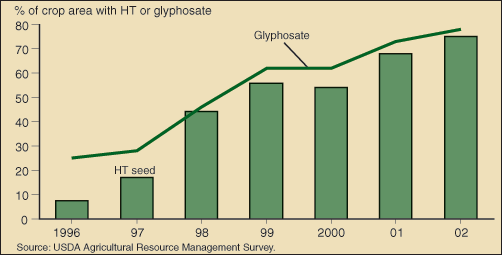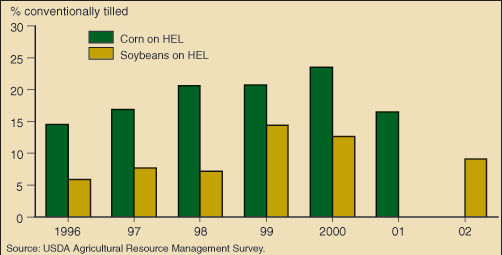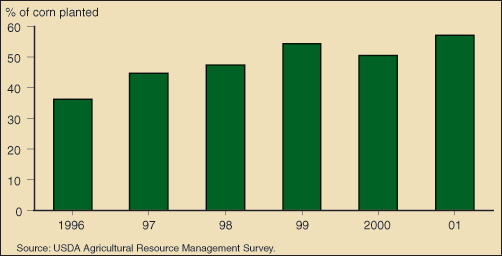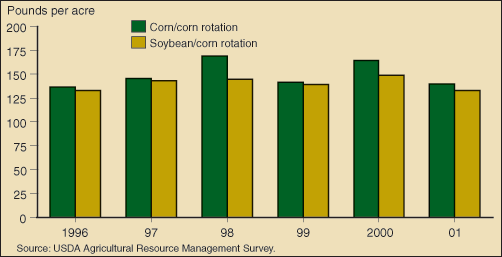Data Feature
- by C.S. Kim, William Quinby and Tim Payne
- 7/1/2006
ARMS Data Highlights Trends in Cropping Practices
Since 1996, U.S. farmers have responded to a number of industry-altering changes, including lower crop prices, the availability of genetically engineered seed, and environmental incentives embodied in farm legislation. How have these changes affected production and conservation practices used by farmers? USDA’s Agricultural Resource Management Survey (ARMS) provides a source of information about practices on sample fields in major field-crop-producing states. Data from 1996 to 2002 show significant trends beginning to emerge, which may have implications for environmental quality.
Genetically Engineered Soybeans
HT seed and glyphosate herbicide use soared...
Use of herbicide-tolerant (HT) soybean seed has enabled farmers to use glyphosate herbicides that are effective in controlling weeds during crop growth.
…while overall herbicide use decreased on soybeans...
With soybean producers relying more on glyphosate herbicides, the number of herbicide treatments has declined. The annual per-acre average of all herbicide active ingredients also declined. Adopting HT soybean varieties has allowed producers to switch to herbicides that are more effective at lower rates of use per acre.
…and cultivation for soybean weed control dropped.
The use of glyphosate herbicides during soybean growth allowed farmers to reduce cultivation for weed control, especially on conventionally tilled soybeans (i.e., soybeans planted on land plowed or tilled so as to leave little or no crop residue, one-fifth of planted acreage in 2002).
Tillage
Conventional tillage trend reversed on highly erodible land
The recent decline in conventional tillage on highly erodible land reverses a previous trend toward greater potential for soil erosion. Soil-conserving tillage is compatible with HT seed and improved herbicides for effective weed control.
Crop Rotation
More corn/soybean rotation in the Northern Plains and Lake States
Rotating corn with soybeans increased in regions where continuous corn production had been the norm. Adding soybeans to the rotation may reduce use of nitrogen fertilizers and insecticides.
Nutrient Management
Nitrogen fertilizer application rates on corn in rotation after soybeans are lower
When nitrogen is applied on corn in rotation following soybeans, the application rates are lower due to the “carryover effect” from the increased soil nitrogen provided by the soybean crop during the previous growing season. This trend lowers the amount of nitrogen fertilizer required for the corn crop and reduces the risk of nitrogen runoff to surface waters.
This article is drawn from:
- ARMS Farm Financial and Crop Production Practices. (n.d.). U.S. Department of Agriculture, Economic Research Service.








